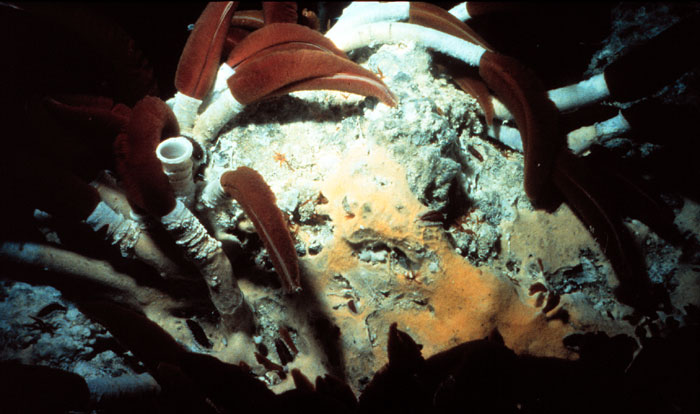Deep-sea Hydrothermal Vents |
| First discovered in 1977, the deep-sea hydrothermal vent communities are loaded with life. Prior to this time it was thought that there were few species that could survive in the deep-sea near any type of volcanic activity and the resulting hot water. However, in 1977 geologists, working near Galapagos, came across huge communities of six foot tall worms and other new species, all near the hot water of hydrothermal vents. |
Black Smokers (NOAA image) |
| Seawater, found in cracks in the ocean bottom, is heated by volcanic activity and it becomes less dense and rises. If this water has come into contact with newly solidified rock it will have leached many minerals from that new rock. In many vent areas the super heated water rises quickly from the ocean bottom with so many minerals that it appears black. As it rises from the seafloor some of the minerals precipitate out and form a 'chimney' around the water vent. These chimneys may grow to over 40 feet high while venting the black mineral-rich heated water. This is what is called a 'black smoker' area. As the chimneys continue to grow they often become clogged with their own minerals and the water vents out of a different area so the 'black smokers' are constantly changing. |
 |
| Large vestimentiferan worms over six feet long are one of the most visible animals at the vents. These are tube worms, secreting a thick paper-like white tube along their body. The vestimentiferans do not have a mouth or gut instead they rely on mutualistic symbiotic bacteria living in their tissues to produce the 'cell food' needed to keep them alive. The discovery of the vent communities was the first time anyone had seen vestimentiferan worms. At first the worms were given their own (new) phylum called Vestimentifera but more recently they have been grouped with the segmented worms in the Phylum Annelida. Most marine annelids are in a taxonomic class called 'Polychaeta' but the vent worms are in a class called 'Pogonophora.' It is believed these worms are some of the fastest growing invertebrates known. |
Vent crab with mussels and worm tubes (NOAA image) |
The chemosynthetic vent bacteria are the base of the food chain at hydrothermal vents. This is a unique community on Earth. Up until 1977 ecologists had believed almost all ecosystems needed photosynthesis as the process that allowed the producers to live and become food for the consumers. Most deep-sea areas known still depended on this photosynthetic base of the food chain (in the form of the 'rain' of organics that sink). But, the vent communities are thriving areas with many species and no plants - instead it was discovered that the vent bacteria were capable of producing 'cell food' by chemosynthesizing the minerals (especially sulfur compounds) in the water. The vents were areas where the seawater had extreme concentrations of dissolved minerals and these bacteria used them to manufacture 'cell food.' As the bacteria bloom there are a large number of filter feeders that exist here (feather duster worms, mussels and clams) and feed on the bacteria in the water. Scavengers, like crabs and shrimp, also are found here along with fish and octopus.
The deep-sea is a vast and complex area and one of the least known on our planet. Some scientists say that we know more about the moon than the deep-sea. It will continue to amaze us for many years. |
|

